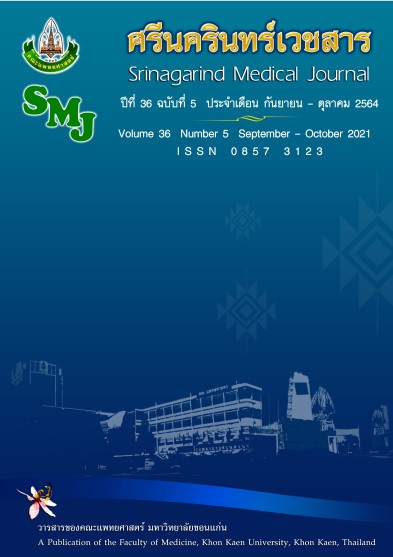อุบัติการณ์และการวิเคราะห์เชิงพื้นที่ของการเกิดมะเร็งตับ ในจังหวัดนครพนม
Abstract
Incidence Rate and Spatial Analysis of Liver Cancer in Nakhon Phanom Province
Oraya Sahat1, Supot Kamsa-ard2*, Apiporn Thinkhamrop Suwannatrai3, Nut Thunyaharn4
1Master student of Master of Public Health Program in Epidemiology, Faculty of Public Health, Khon Kaen University
2Department of Epidemiology and Biostatistics, Faculty of Public Health, Khon Kaen University
3Department of Parasitology, Faculty of Medicine, Khon Kaen University
4 Nakhon Phanom Hospital, Nakhon Phanom Province
*Corresponding author: Supot Kamsa-ard,Department of Epidemiology and Biostatistics, Faculty of Public Health, Khon Kaen University, E-mail: supot@kku.ac.th
บทคัดย่อ
หลักการและวัตถุประสงค์: อุบัติการณ์มะเร็งตับ จังหวัดนครพนม มีแนวโน้มเพิ่มขึ้น ปัจจัยเชิงพื้นที่เป็นอีกปัจจัยหนึ่งที่สำคัญ วัตถุประสงค์เพื่อวิเคราะห์ปัจจัยเชิงพื้นที่และศึกษาอุบัติการณ์มะเร็งตับในจังหวัดนครพนม
วิธีการศึกษา: Retrospective descriptive study ผู้ป่วยมีภูมิลำเนาในจังหวัดนครพนมและรักษาที่โรงพยาบาลนครพนม ระหว่าง 1 มกราคม 2553 ถึง 31 ธันวาคม 2562 จำนวน 1,899 ราย ปัจจัยที่ศึกษา ได้แก่ ข้อมูลส่วนบุคคล ภูมิอากาศและสิ่งแวดล้อม หาความสัมพันธ์ระหว่างปัจจัยกับอุบัติการณ์มะเร็งตับ โดย Moran's I และ Anselin Local Moran's I, LISA และวิเคราะห์อุบัติการณ์พร้อมนำเสนอช่วงเชื่อมั่น 95%
ผลการศึกษา: อุบัติการณ์มะเร็งตับ จังหวัดนครพนม 22.5 ต่อประชากรแสนคนต่อปี (95% CI: 21.5 - 23.5) การวิเคราะห์ Moran’s I พบตัวแปรที่มีความสัมพันธ์เชิงพื้นที่ในทิศทางเดียวกันแบบเกาะกลุ่ม (clustered) อย่างมีนัยสำคัญทางสถิติ (p < 0.05) ได้แก่ระยะห่างจากแหล่งน้ำ ความหนาแน่นประชากรและความสูงจากระดับน้ำทะเล การวิเคราะห์ LISA จาก 99 ตำบล กลุ่มตำบลที่เกิดมะเร็งตับ ได้แก่ตัวแปรความสูงจากระดับน้ำทะเล 4 ตำบล ตัวแปรระยะห่างจากแหล่งน้ำ 22 ตำบล ตัวแปรความหนาแน่นของประชากร 14 ตำบล
สรุป : อุบัติการณ์มะเร็งตับสูงอยู่ในพื้นที่และติดกับเขตอำเภอเมือง โดยพบว่าเป็นการเกิดแบบเกาะกลุ่ม ดังนั้นควรค้นหาปัจจัยในเชิงลึก ทั้งนี้เพื่อการป้องกันและควบคุมมะเร็งตับในระดับพื้นที่และประเทศต่อไป
คำสำคัญ : อุบัติการณ์; การวิเคราะห์เชิงพื้นที่; มะเร็งตับ
Abstract
Background and Objective: Incidence of Liver cancer (LC) in Nakhon Phanom province tends to increase. The spatial factor is an important factor. The purpose of this study was to analyze spatial factors and incidences rate of LC in Nakhon Phanom province.
Methods: A retrospective descriptive study was used for this study. Of 1,899 LC patients lived in Nakhon Phanom province and treated in Nakhon Phanom hospital between January 1, 2010 to December 31, 2019 were obtained from the Hospital-database. The studied factors were personnel profile, climatic and environmental factors. The Moran's I and Anselin Local Moran's I, LISA determined relationship. The Age-Standardized Rate, ASR were reported with their 95% confidence interval.
Result: The ASR of LC was 22.5 per 100,000 population year (95%CI: 21.5 to 23.5). Moran’s I analysis was spatially correlated with variables. The statistical significance of the clustered pattern were the distance from the water resources, population density, and altitude variables (p < 0.05). The LISA, 99 sub-districts with LC incidence according to the following variables; 4 sub-districts as for attitude, 22 sub-districts as for distance from the water resources and in14 sub-districts as for population density.
Conclusion: LC is a high incidence rate in the sub-district area and adjacent area in Muang district. It is also found as the clustered of LC. Further research should focus on the relationship between exposure and LC in this area have affected the incidences in Thailand might shed some new light on the prevention and control of LC.
Keywords: Incidence rate; spatial analysis; Liver cancer


